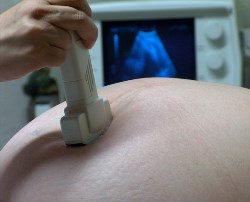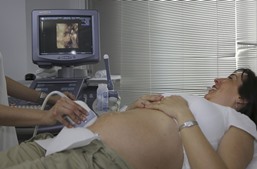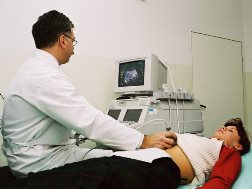How to Find the Best Ultrasound Technician College near Roaring Branch Pennsylvania
 Once you have decided to obtain an ultrasound technician degree near Roaring Branch PA, the next step is to begin the process of selecting a school. First, you have to find the ideal program that will provide the appropriate training to become a qualified professional. And because a number of states do mandate that sonographers be either certified or licensed, depending on where you will practice you may also need to be prepared to pass a certification or licensing exam. So it’s extremely important that you research each college so that you can evaluate and compare your options. But just where does one begin? A number of students will start by looking for schools that are within driving distance of their homes and then by comparing tuition. Certainly cost and location should be considered when making a decision, but there are other critical factors also. For example, if the ultrasound technician schools have earned accreditation or if they offer internship programs. These and other qualifications will be covered more in depth later in this article. But first, let’s go over what an ultrasound tech does and the credentials and online education programs that are available.
Once you have decided to obtain an ultrasound technician degree near Roaring Branch PA, the next step is to begin the process of selecting a school. First, you have to find the ideal program that will provide the appropriate training to become a qualified professional. And because a number of states do mandate that sonographers be either certified or licensed, depending on where you will practice you may also need to be prepared to pass a certification or licensing exam. So it’s extremely important that you research each college so that you can evaluate and compare your options. But just where does one begin? A number of students will start by looking for schools that are within driving distance of their homes and then by comparing tuition. Certainly cost and location should be considered when making a decision, but there are other critical factors also. For example, if the ultrasound technician schools have earned accreditation or if they offer internship programs. These and other qualifications will be covered more in depth later in this article. But first, let’s go over what an ultrasound tech does and the credentials and online education programs that are available.
Click Here to Get Free Information on Ultrasound Technician Schools!
Ultrasound Technician Occupation Summary
 There are multiple acceptable titles for ultrasound techs (technicians). They are also referred to as ultrasound technologists, sonogram techs, and diagnostic medical sonographers (or just sonographers). No matter what their title is, they all have the same primary job function, which is to perform diagnostic ultrasound techniques on patients. Although many work as generalists there are specialties within the profession, for example in cardiology and pediatrics. The majority practice in Roaring Branch PA clinics, hospitals, outpatient diagnostic imaging centers and even private practices. Routine daily work tasks of a sonogram technician can consist of:
There are multiple acceptable titles for ultrasound techs (technicians). They are also referred to as ultrasound technologists, sonogram techs, and diagnostic medical sonographers (or just sonographers). No matter what their title is, they all have the same primary job function, which is to perform diagnostic ultrasound techniques on patients. Although many work as generalists there are specialties within the profession, for example in cardiology and pediatrics. The majority practice in Roaring Branch PA clinics, hospitals, outpatient diagnostic imaging centers and even private practices. Routine daily work tasks of a sonogram technician can consist of:
- Maintaining records of patient case histories and details of each procedure
- Counseling patients by explaining the procedures and answering questions
- Preparing the ultrasound machines for usage and then sterilizing and recalibrating them
- Transferring patients to treatment rooms and ensuring their comfort
- Using equipment while limiting patient exposure to sound waves
- Evaluating results and determining necessity for additional testing
Ultrasound techs must regularly assess the safety and performance of their machines. They also must adhere to a high ethical standard and code of conduct as medical practitioners. So as to sustain that level of professionalism and remain up to date with medical knowledge, they are required to enroll in continuing education training on a regular basis.
Sonogram Technician Degree Programs Offered
 Ultrasound technician enrollees have the opportunity to earn either an Associate or a Bachelor’s Degree. An Associate Degree will normally involve about 18 months to 2 years to complete dependent on the program and class load. A Bachelor’s Degree will take longer at as long as four years to finish. Another alternative for those who have already earned a college degree is a post graduate certificate program. If you have obtained a Bachelor’s Degree in any major or an Associate Degree in a relevant health sector, you can instead choose a certificate program that will take only 12 to 18 months to finish. Something to keep in mind is that the majority of ultrasound technician programs do have a practical training element as part of their curriculum. It often may be satisfied by participating in an internship program which numerous schools sponsor with Roaring Branch PA hospitals and clinics. When you have graduated from any of the certificate or degree programs, you will then need to comply with the certification or licensing requirements in Pennsylvania or whatever state you choose to work in.
Ultrasound technician enrollees have the opportunity to earn either an Associate or a Bachelor’s Degree. An Associate Degree will normally involve about 18 months to 2 years to complete dependent on the program and class load. A Bachelor’s Degree will take longer at as long as four years to finish. Another alternative for those who have already earned a college degree is a post graduate certificate program. If you have obtained a Bachelor’s Degree in any major or an Associate Degree in a relevant health sector, you can instead choose a certificate program that will take only 12 to 18 months to finish. Something to keep in mind is that the majority of ultrasound technician programs do have a practical training element as part of their curriculum. It often may be satisfied by participating in an internship program which numerous schools sponsor with Roaring Branch PA hospitals and clinics. When you have graduated from any of the certificate or degree programs, you will then need to comply with the certification or licensing requirements in Pennsylvania or whatever state you choose to work in.
Sonographer Online Classes
 As earlier discussed, nearly all ultrasound technician colleges have a practical component to their programs. So while you can receive a degree or certificate online, a significant portion of the training will be either carried out in an on-campus lab or at an authorized off campus facility. Clinical training can often be fulfilled through an internship at a local Roaring Branch PA hospital, outpatient clinic or private practice. However the remainder of the classes and training can be accessed online in your Roaring Branch home. This is especially beneficial for those individuals that continue working while earning their degrees. Plus online colleges are frequently more affordable than on-campus options. Expenditures for commuting and study materials can be decreased also. But similarly as with every sonographer school you are reviewing, confirm that the online program you select is accredited. Among the most highly respected accrediting agencies is the Commission on Accreditation of Allied Health Education Programs (CAAHEP). Accreditation is particularly crucial for licensing, certification and job placement (more on accreditation later). So if you are disciplined enough to learn outside of the classroom in the convenience of your own home, then online classes could be the right choice for you.
As earlier discussed, nearly all ultrasound technician colleges have a practical component to their programs. So while you can receive a degree or certificate online, a significant portion of the training will be either carried out in an on-campus lab or at an authorized off campus facility. Clinical training can often be fulfilled through an internship at a local Roaring Branch PA hospital, outpatient clinic or private practice. However the remainder of the classes and training can be accessed online in your Roaring Branch home. This is especially beneficial for those individuals that continue working while earning their degrees. Plus online colleges are frequently more affordable than on-campus options. Expenditures for commuting and study materials can be decreased also. But similarly as with every sonographer school you are reviewing, confirm that the online program you select is accredited. Among the most highly respected accrediting agencies is the Commission on Accreditation of Allied Health Education Programs (CAAHEP). Accreditation is particularly crucial for licensing, certification and job placement (more on accreditation later). So if you are disciplined enough to learn outside of the classroom in the convenience of your own home, then online classes could be the right choice for you.
Topics to Ask Sonography Schools
 Now that you have determined which degree or certificate that you would like to earn, you can begin the process of assessing and comparing ultrasound technician colleges. You will first probably want to choose whether you will access classes online or commute to a school campus in the Roaring Branch PA area. Obviously location will be significant if you select the latter, and the price of tuition no doubt will be an initial qualifier also. But there are other variables that you should also take into account, for instance if the programs are accredited and if they offer internship programs. So in order to perform your due diligence so that you can make your final selection, below are several questions that you may want to ask each ultrasound tech school before deciding.
Now that you have determined which degree or certificate that you would like to earn, you can begin the process of assessing and comparing ultrasound technician colleges. You will first probably want to choose whether you will access classes online or commute to a school campus in the Roaring Branch PA area. Obviously location will be significant if you select the latter, and the price of tuition no doubt will be an initial qualifier also. But there are other variables that you should also take into account, for instance if the programs are accredited and if they offer internship programs. So in order to perform your due diligence so that you can make your final selection, below are several questions that you may want to ask each ultrasound tech school before deciding.
Are the Sonogram Tech Programs Accredited? A large number of ultrasound tech colleges have acquired some form of accreditation, whether regional or national. Nevertheless, it’s still crucial to verify that the program and school are accredited. Among the most highly regarded accrediting organizations in the field of sonography is the Joint Review Committee on Education in Diagnostic Medical Sonography (JRC-DMS). Programs obtaining accreditation from the JRC-DMS have gone through a rigorous examination of their teachers and educational materials. If the school is online it can also obtain accreditation from the Distance Education and Training Council, which focuses on online or distance education. All accrediting organizations should be acknowledged by the U.S. Department of Education or the Council on Higher Education Accreditation. Along with ensuring a premium education, accreditation will also assist in getting financial assistance and student loans, which are frequently not offered for non-accredited schools. Accreditation might also be a pre-requisite for licensing and certification as required. And many Roaring Branch PA health facilities will only hire a graduate of an accredited program for entry level positions.
Are Internship Programs Offered? Ask if the sonogram tech schools you are evaluating have associations with Roaring Branch PA clinics or hospitals for internship programs. Internships are not only a great way to get practical training in a clinical environment, they are also a way to fulfill the practical training requirement for most programs. As an ancillary benefit, they can help graduates and students establish professional relationships in the Roaring Branch healthcare community and assist with obtaining employment.
Is Job Placement Help offered? You will undoubtedly wish to secure employment quickly after graduating, but getting that initial job in a new field can be challenging without assistance. Find out if the ultrasound tech programs you are interviewing have job assistance programs and what their placement rates are. High and rapid placement rates are a good sign that the schools have sizable networks and great relationships with Pennsylvania healthcare employers. It also substantiates that their students are well regarded and sought after.
Where is the School Located? For a number of students, the college they decide on will need to be within commuting distance of their Roaring Branch PA home. Individuals who have decided to attend online classes naturally will not have to trouble themselves with the location of the campus. However, the availability of area internships will be of concern. One thing to consider is that if you choose to enroll in a school that is out of state or perhaps out of your local area, you might be required to pay a higher tuition. State colleges generally charge higher tuitions for out of state residents. And community colleges generally charge a higher tuition to those students that don’t reside within their districts.
How Big are the Classes ? Unless you are the kind of person that prefers to sit far in the back of the classroom or hide in the crowd, you will probably want a smaller class size. Smaller classes permit more individual participation and personalized instruction. Ask the schools you are looking at what the average teacher to student ratio is for their classrooms. If practical you may want to sit in on one or more classes before making your final determination. This will also give you a chance to talk with a few of the students and instructors to get their opinions regarding the sonogram tech program also.
Can the Program Accommodate your Schedule? And finally you need to verify that the sonographer college you finally select can provide the class schedule you need. This is especially essential if you choose to continue working while you attend classes. If you need to schedule evening or weekend classes in the Roaring Branch PA area, make certain that they are offered. If you can only enroll on a part-time basis, find out if that is an option and how many credit hours or courses you would have to carry. Also, ask what the procedure is for making up any classes that you might miss because of work, illness or family emergencies.
Best Diagnostic Medical Sonography Schools Roaring Branch Pennsylvania
 Enrolling in the right sonographer certificate or degree program is an important first step to starting a fulfilling new career furnishing diagnostic services to patients. Sonographer schools require that you have earned a high school diploma or equivalent. In addition to satisfying academic requirements, you need to be in at least fairly good physical condition, capable of standing for prolonged periods and able to routinely lift weights of fifty pounds or more, as is it frequently necessary to position patients and maneuver heavy machines. Other helpful skills include technical proficiency, the ability to keep calm when confronted by an anxious or angry patient and the ability to communicate in a clear and compassionate manner. You originally came to this website due to an interest in Best Diagnostic Medical Sonography Schools and wanting more information on Certified Diagnostic Medical Sonography Schools. However, as we have covered in this article, there are several questions that you should ask each school you are looking at. This is the case whether you choose an online degree or commute to the college campus to attend classes. And by asking the appropriate questions so that you can assess each program, you can narrow down your choices until you are left with the best program for your education. And with the right training, discipline and motivation to succeed, you can achieve your goal to practice as an sonographer in Roaring Branch PA.
Enrolling in the right sonographer certificate or degree program is an important first step to starting a fulfilling new career furnishing diagnostic services to patients. Sonographer schools require that you have earned a high school diploma or equivalent. In addition to satisfying academic requirements, you need to be in at least fairly good physical condition, capable of standing for prolonged periods and able to routinely lift weights of fifty pounds or more, as is it frequently necessary to position patients and maneuver heavy machines. Other helpful skills include technical proficiency, the ability to keep calm when confronted by an anxious or angry patient and the ability to communicate in a clear and compassionate manner. You originally came to this website due to an interest in Best Diagnostic Medical Sonography Schools and wanting more information on Certified Diagnostic Medical Sonography Schools. However, as we have covered in this article, there are several questions that you should ask each school you are looking at. This is the case whether you choose an online degree or commute to the college campus to attend classes. And by asking the appropriate questions so that you can assess each program, you can narrow down your choices until you are left with the best program for your education. And with the right training, discipline and motivation to succeed, you can achieve your goal to practice as an sonographer in Roaring Branch PA.
More Ultrasound Locations in Pennsylvania
Roaring Spring, Pennsylvania
Roaring Spring was established around the Big Spring in Morrison's Cove, a clean and dependable water source vital to the operation of a paper mill. Prior to 1866, when the first paper mill was built, Roaring Spring had been a grist mill hamlet with a country store at the intersection of two rural roads that lead to the mill near the spring. A grist mill, powered by the spring water, had operated at that location since at least the 1760s. After 1867, as the paper mill expanded, surrounding tracts of land were acquired to accommodate housing development for new workers. The formalization of a town plan, however, never occurred. As a result, the seemingly random street pattern of the historic district is the product of hilly topography, a small network of pre-existing country roads that converged near the Big Spring, and the property lines of adjacent tracts that were acquired through the years for community expansion. The arterial streets of the district are now East Main, West Main, Spang and Bloomfield, each of which leads out of the borough to surrounding townships. Two of these streets — Spang and East Main — meet with Church Street at the district's main intersection called "Five Points." The boundaries of the district essentially include those portions of Roaring Spring Borough which had been laid out for development by the early 1920s. This area encompasses 233 acres (0.94 km2) or 55 percent of the borough's area of 421 acres (1.70 km2). Since the district's period of significance extends to 1944, most of those buildings erected after the 1920s were built as infill within the areas already subdivided by the 1920s. In the early 1960s, the Borough began to annex sections of adjacent Taylor Township, especially to the east around the then new Rt. 36 Bypass.
Daniel Mathias (D. M.) Bare laid out Roaring Spring's first 50 building lots in 1865 after he and two partners decided to locate the region's first paper mill near the spring.[3] These lots were located within and around the so-called village "triangle" defined by West Main, Spang, and East Main Streets. By 1873, the borough contained about 170 lots and 50 buildings, which included the paper and grist mills, three churches, a company store, a schoolhouse, and one hotel. The population stood at about 100. The triangle remained the industrial, commercial and retailing core of the town until 1957 when the bypass of Main Street, PA Rt. 36, was built to the east of town through Taylor Township. As is true of many American small towns, many village merchants along with new businesses have since relocated to the new highway. The village core retains only a few shops and professional offices, but still holds the Roaring Spring Blank Book Company and Roaring Spring Water Bottling Company, all of the historic church buildings, the public library(formerly the Eldon Inn), the borough building, the post office(earlier moved from farther up East Main St.). The elementary school (former junior-senior high school)was demolished in 2010.
The Roaring Spring Historic District is located within the Borough of Roaring Spring, a paper-mill town of about 2,600 established in the late 1860s in southern Blair County, south-central Pennsylvania.[1] Roaring Spring is situated within the northwest quadrant of a long bowl-like valley known as Morrisons Cove, one of dozens of long but broad valleys in Pennsylvania's Ridge and Valley region. The town developed just southeast of a natural pass into the valley called McKee's Gap where an important iron smelting business (Martha Furnace) operated through the mid 19th century. The site of Roaring Spring is moderately hilly, drained by Cabbage and Halter Creeks. The most prominent natural feature is the Big Spring, or Roaring Spring, a large natural limestone spring so-called because of the great noise its eight-million-gallon-a-day stream once made rushing out of the hillside near the village center.[2] Roaring Spring is overwhelmingly residential (91 percent) in scale, but also includes churches, stops, professional offices, a municipal building, parks, a cemetery, a book factory complex, and a former railroad station. Most houses are two-story, wood-frame single-family buildings situated on lots of 1⁄5 acre (810 m2) to 1⁄7 acre (580 m2). The largest segment of the building stock between 1865 and 1944 was constructed between the 1890s and 1930s. Architecturally, the district contains a variety of late 19th to early 20th century styles and vernacular building types, including Gothic Revival, Queen Anne, Colonial Revival, Bungalow, Foursquare, Gable Fronts, Gable Fronts & Wings, I Houses, and double-pile Georgian types. Ninety (90) percent of the district's 643 properties is rated as contributing. The remaining 10 percent consists of buildings less than 50 years old (constructed after 1944) or older buildings whose architectural integrity has been lost through inappropriate alterations. Overall, most alterations, such as inappropriate replacement of windows, doors and porch posts, are reversible if desired.[4]
